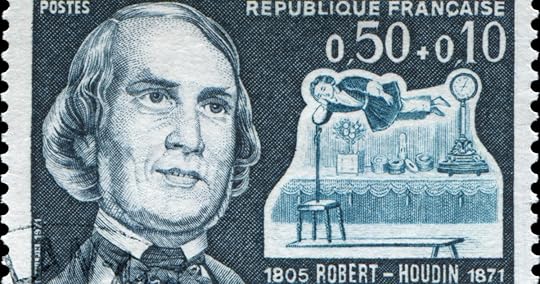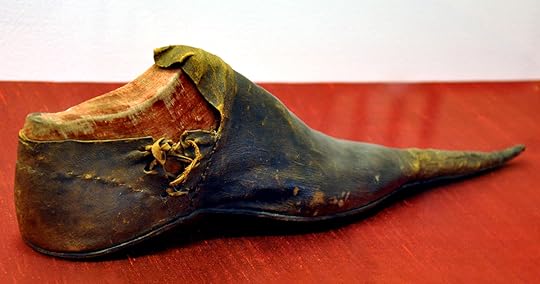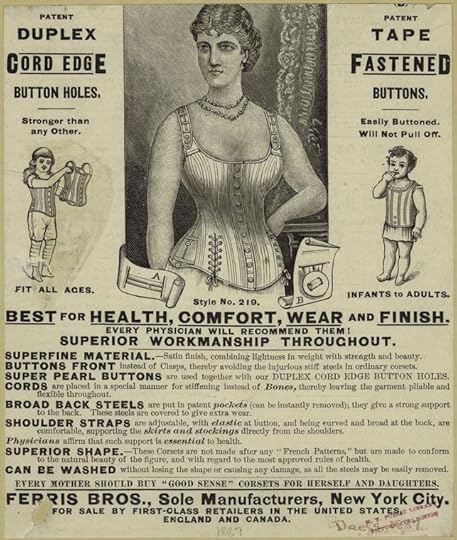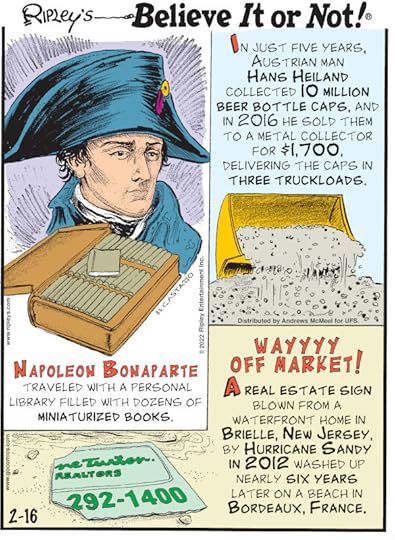Ripley Entertainment Inc.'s Blog, page 101
February 21, 2022
How Robert-Houdin Quelled A Rebellion With Illusions And Magic
Featured in Ripley's Believe It or Not!

Widely considered the father of modern magic, French performer Jean-Eugène Robert-Houdin (1805–1871) discovered his deep-rooted love for these tricks at a young age. Robert-Houdin would attend his famous friends’ magic shows, making sure to pay close attention to any mistakes or mishaps they made along the way in case he ever took his tricks to the big leagues.
By day, Robert-Houdin spent his time building clocks for his family’s business. With this experience, he branched out and created other devices, including a small automaton that was later bought by circus legend P.T. Barnum. Robert-Houdin even built a theater he could call his own at the old Palais Royal in Paris. He was a natural on stage, and the fact that he wore regular evening attire rather than elaborate robes while performing caught the eyes of his colleagues and audience members.
Embed from Getty Imageswindow.gie=window.gie||function(c){(gie.q=gie.q||[]).push(c)};gie(function(){gie.widgets.load({id:'sTuTsXRdSHR3u68jyoWXRQ',sig:'Oei-2TGNVwIsaoimQ6od--IwYtRFgcFNSmf9B7Hj1wM=',w:'405px',h:'594px',items:'89859672,952015470',caption: true ,tld:'com',is360: false })});
How It BeganHis biggest feat of all wasn’t just building his own theater — although that’s surely impressive enough. In 1856, French Emperor Louis-Napoléon Bonaparte III requested Robert-Houdin’s help in acquiring the French colony of Algeria after a rebellion of Algerian natives struck concern.
The emperor wanted to keep control of the colony and stop the religious holy men of the region, also known as marabouts, from encouraging rebellion, which they did through performing illusions. Some examples of these acts by marabouts were fire walking and snake charming. These performances would help convince their people that the mission (a.k.a. rebellion) was approved by Allah.
To avoid a battle of bloodshed, Napoleon III sought to simply prove French magic could outdo Algerian magic. There was hope that this tactic would catch the rebels by surprise and weaken their excitement to rebel and take back the colony.
How It Went DownRobert-Houdin met local leaders at a theater and performed a variety of tricks, including pulling a seemingly impossible number of objects from a hat. He also allowed a rebel to shoot a marked bullet at him voluntarily. By a miracle (or should we say, by magic), he caught the bullet between his teeth!
As if that wasn’t wild enough, he then proceeded to prove to the marabouts how weak they were — literally. Robert-Houdin placed a small box with a handle on the ground and asked their strongest warrior to come lift the box. The muscular fellow did so the first time around with little to no effort.
But following a wave of Robert-Houdin’s magic wand and some clever words, the rebel warrior found he could no longer move the box. After several minutes of struggling, the defeated man let out a scream and fled from stage. The magician’s secret? An electromagnet underneath the floor to hold the box down, plus an electric shock to surprise the volunteer and send him running.
Embed from Getty Imageswindow.gie=window.gie||function(c){(gie.q=gie.q||[]).push(c)};gie(function(){gie.widgets.load({id:'5_4dAba-RfxiYSbzixXjRQ',sig:'HHe6QBuKJI21xXFJ95SKnqT_mkRd6wclTlJz1VYxdpE=',w:'594px',h:'469px',items:'1367941834',caption: true ,tld:'com',is360: false })});
His performance not only broke the influence of the holy men but frightened them of what else Robert-Houdin was capable of. They realized their guns were merely useless and would never be as powerful as those of the French militia. Algeria remained a French colony for another year.
Whether or not that was a direct result of Robert-Houdin’s performance is difficult to say. However, his influence on future magicians is indisputable — just ask the man who named himself after the Frenchman: Harry Houdini.
By Sam McCormack, contributor for Ripleys.com
EXPLORE THE ODD IN PERSON! Discover hundreds of strange and unusual artifacts and get hands-on with unbelievable interactives when you visit a Ripley’s Odditorium!Source: How Robert-Houdin Quelled A Rebellion With Illusions And Magic
CARTOON 02-21-2022
February 20, 2022
CARTOON 02-20-2022
February 19, 2022
CARTOON 02-19-2022
February 18, 2022
Decoded DNA Takes Tasmanian Tiger One Step Closer to Resurrection
Featured in Ripley's Believe It or Not!

It was a great week for the Tasmanian tiger, or thylacine, as the apex predator clawed its way back into the headlines — giving hope for resurrection 86 years after being declared extinct.
The Tasmanian tiger’s press tour began on February 9 when the DNA Zoo Australia research collective announced that they had completed DNA decoding that could give the extinct mammal a second chance to roam the earth.
Humble BeginningsUsing a blood sample provided by Perth Zoo, researchers from DNA Zoo and the University of Western Australia successfully mapped the DNA of the Tasmanian tiger’s closest living relative, the humble numbat.
Beyond sharing the same stripes as its elusive cousin, the numbat’s DNA was revealed to be 95% identical — a remarkable percentage for two creatures that shared a common ancestor between 35 million and 41 million years ago.

A numbat, the Tasmanian tiger’s closest living relative.
The organization has high hopes that their latest research will help fill in the blanks of a 2018 project in which researchers produced a fragmented “first draft” of the Tasmanian tiger’s genome using specimens from museums.
If all goes well, scientists will be able to clone the DNA of the numbat to bring the Tasmanian tiger roaring back to life and reintroduce it to its native ecosystem.
“If and when that dream becomes reality, thylacines would owe a debt of gratitude to their little cousin, the humble numbat,” the group surmised.
Another Type of ResurrectionA few days after DNA Zoo announced their big news, researcher Andrew Vamvatsikos unearthed two lost film clips of the elusive creature while perusing the Tasmanian Archives and Heritage Office online.
Shot by psychiatrist Dr. Randle Stewart while visiting Tasmania’s Beaumaris Zoo while vacationing in 1931, the footage features Benjamin, the last living Tasmanian tiger who was held in captivity until dying from suspected neglect in September 1936.
The “Stewart film” has been a legend among Tasmanian tiger enthusiasts and researchers for decades after disappearing at some point between 1978 and 1983.
Now available for all to see, the first clip, “Tasmanian Wolf,” shows a close-up of a baby Benjamin walking around his enclosure, while the second depicts a Tasmanian devil with Benjamin strolling along in the background. It is the only known recording of the two creatures together.
The resurrected films are two of only 13 existing pieces of footage featuring the Tasmanian tiger — a compilation that runs only four minutes long.
Colonization and the Downfall of the Tasmanian TigerThe extinction of the Tasmanian tiger is not the result of evolution alone. Native to Tasmania and New Guinea, the marsupials roamed the jungles of Australia until the British sailed into town in 1808.
Despite food scarcity already decimating the thylacines’ population, the settlers branded them a threat to their interests, organizing group hunts to take them out so fast there was barely time for researchers to study the mysterious creatures.

With an actual bounty on their heads, the wild Tasmanian tiger didn’t stand a chance. Attempts at keeping a few in captivity were unsuccessful, with most falling ill or refusing to eat, breeding attempts an overall failure, and transfers out of the country too pricey to justify.
Since Benjamin’s death, the Tasmanian tiger has lived on as a cryptid as legendary as the Loch Ness Monster, with even media mogul Ted Turner offering a reward for proof of life in 1983.
The latest news could be great for Ted and his fellow thylacine hunters (despite Turner rescinding his offer in 2000), as their potential resurrection will hopefully bring a happy ending to their sad tale — or cause a kerfuffle with arguments that they’ve been here all along.
By Meghan Yani, contributor for Ripleys.com
EXPLORE THE ODD IN PERSON! Discover hundreds of strange and unusual artifacts and get hands-on with unbelievable interactives when you visit a Ripley’s Odditorium!Source: Decoded DNA Takes Tasmanian Tiger One Step Closer to Resurrection
CARTOON 02-18-2022
February 17, 2022
Why Did People In The Middle Ages Wear Long And Pointy Shoes?
Featured in Ripley's Believe It or Not!

Crakows, also known as the poulaine, were a popular style of pointed and elongated shoes favored by nobility during the medieval period. The shoes featured long, skinny points that extended outwards from the toes, and the points could be as long as four to 20 inches, according to Shoe IQ. But why were they such a fashionable item for nearly 150 years during the 14th and 15th centuries?
Named after the Polish city of Kraków (Cracow), the shoes were worn by anyone in Europe who could afford them. They were commonly stuffed with moss and other types of filling to keep their shape, so they didn’t flop around, reports The Met. They often featured decorative elements and embossing and were typically made of leather, but other materials were also used in their construction.
Style of the Rich and FamousHowever, shoes with the extra-long tips were usually relegated to the wealthiest people who could afford to walk around in such impractical footwear, according to Atlas Obscura. Essentially, the shoes were a status symbol for the rich, just like private jets, yachts, and expensive watches are today.

A 1447 painting featuring nobles wearing poulaines.
The length of a person’s shoe tips essentially showed how wealthy they were. The shoes with ridiculously long toes were exorbitantly priced and would inhibit the user from doing any type of manual labor. Sometimes, the men would use a whalebone or tie a string or gold or silver chains to their knees from the shoes in order to prevent them from tripping, according to FIT. The poulaine showed that the wearer lived a life of leisure.
Other Reasons for the Poulaine’s PopularityWorn largely by men, although by some women as well, crakows could be quite sexy because they were low cut and showed off a man’s ankles during a time when they wore shorter tunics and revealed more of their legs.
Jackie Keily, senior curator at the Museum of London, which houses a large collection of poulaines, told Atlas Obscura that the footwear became popular not long after the Black Death, or bubonic plague, killed an estimated 25 million people. This type of “retail therapy” may have been a coping mechanism in response to so much tragedy.

Different styles of crakows worn in 15th-century Europe.
But Why Were They Popular for So Long?One explanation for why the fashion trend lasted so long is that during the Middle Ages it took a long time for trends to make their way across various cities and countries. After all, people didn’t have television or social media to influence their fashion choices. Instead, a trend would develop in the upper class and eventually make its way down to the lower classes. It could take many years before a popular fashion hit rural communities.
Instead of simply going out of style in England, the poulaine met its end in the court of King Edward IV. This was partly due to their salacious undertones of the shoes as some believed the longer the points on the toes were, the bigger his you-know-what was. The poulaine was deemed indecent, and a law was passed in 1463 that banned shoe tips longer than two inches. Paris had previously prohibited them in 1368 as instructed by King Charles V because it was reportedly tough for those who wore them to kneel in prayer. By 1475, they were no longer fashionable.
Lasting ImpressionsInterestingly, there was a resurgence in England the 1950s, although the pointy shoes were dubbed the winklepicker. These shoes weren’t as obnoxiously pointy as the poulaine, but they had similar stuffing in the tips to resemble the shoes favored by medieval nobility.
By Noelle Talmon, contributor for Ripleys.com
EXPLORE THE ODD IN PERSON! Discover hundreds of strange and unusual artifacts and get hands-on with unbelievable interactives when you visit a Ripley’s Odditorium!Source: Why Did People In The Middle Ages Wear Long And Pointy Shoes?
CARTOON 02-17-2022
February 16, 2022
How Tuberculosis Influenced Victorian Fashion
Featured in Ripley's Believe It or Not!

Before influencers and advertisements, fashion relied on other factors to steer trends — including deadly diseases. One of the oldest diseases in human history, tuberculosis has had lasting impacts on the world. But it also had an unexpected influence on Victorian fashion when people began to romanticize it.
Life in the Victorian EraThe Victorian era (1837–1901) was a time of immense industrial growth. The United Kingdom was under the reign of Queen Victoria and made strides in the production of coal, iron, steel, and textiles, as well as scientific and artistic breakthroughs and influences. Under her reign, the engineering marvel that was the London and Birmingham Railway became a reality. These innovations and industrial changes even led to the modern steampunk subculture that draws heavily on the advancements of the 19th century.
During this time, The Great Exhibition of the Works of Industry of All Nations opened. It was a World Fair that showcased industrial contributions and influential cultural items from around the world. Queen Victoria gave the opening ceremony, and while it was open, 6 million people came to view these exhibits.

Crystal Palace built for the Great Exhibition of 1851 © The Trustees of the British Museum (CC BY-NC-SA 4.0)
But the Victorian era wasn’t a time of success and celebration for all — especially for the poorer classes in London. The gap between the classes only grew during this time, and poverty rates increased. Diseases spread rampantly, and the poor were forced to live in cramped quarters and work in dangerous places like mines and factories.
As if daily life wasn’t scary enough, it was during the Victorian era that Jack the Ripper was active. Many people lived in fear of being killed or dying of a disease like cholera or tuberculosis.
Tuberculosis Hit HardTuberculosis is one of the oldest known diseases, and even mummies have shown evidence of the illness in their spines. It is still around today, and it is estimated that more than one billion people have died from it throughout history.
When tuberculosis began to spread with fervor during the Victorian era, the way it was contracted still wasn’t fully understood. It became an epidemic and heavily impacted life in Europe and North America. During this time, it killed nearly 1 in 5 people, and around 40 percent of deaths in heavily populated cities were caused by the disease.
It was often called “consumption” because of how much weight those inflicted with tuberculosis lost. Another nickname was “the white plague” because of how pale people would become. And yet, its final nickname was “the romantic disease.” People became enamored with the physical effects of contracting the illness. Pale skin, thin waists, and flushed lips and cheeks from long-term fevers were seen as quite desirable. “Consumption, I am aware, is a flattering malady,” Charlotte Brontë wrote in a letter as she watched her sister fall ever sicker with the disease.

A sickly young woman sits covered up on a balcony; Death is standing next to her, representing tuberculosis. By R. Cooper, c. 1912.
Consumption Changed Life and FashionThose that became ill with tuberculosis tended to die slowly. Often, especially for the wealthy, people were instructed by their doctors to head to a relaxing area with fresh air, spend time in the sun, and relax. The sick were often introspective and thoughtful, and seemed to have time to move at a slow pace; others even viewed them with jealousy.
As the disease took hold further, scientists began to understand germ theory and transmission. More women were getting sick than men, and they began to realize that it wasn’t sanitary to have long trains flowing behind them and dragging through the spit-covered streets. So, gowns shortened and lost their trains. This made it so that shoes were more visible, making their appearance more important.

American satirical cartoon featuring the grim reaper following a maid brushing off a trailing skirt shown as a carrier of germs, including consumption. By S. Ehrhart, c. 1900.
Though thin waists became popular and women that were ill got slimmer, people realized that emulating the look with restrictive lung-squishing boned corsets might not be the most comfortable option when tuberculosis caused rough bouts of coughing on its own. That led to the more flexible so-called “health corsets” and dresses that were cinched at the waist to allow for a slimming effect without the tight pressure.

The Miriam and Ira D. Wallach Division of Art, Prints and Photographs: Picture Collection, The New York Public Library. (1887)
Voluminous skirts that gave the appearance of a slimmer waist became popular, too. The flowing carefree ways of the Georgian era were replaced by practicality and attempts to imitate the look the disease gave. The light fabrics gave way to thicker and sturdier materials. Consumption made the women who were ill appear much weaker and more subdued, and fashion leaned back toward the puritanical to emulate this. Those who were not sick powdered their face to appear pale, rouged their cheeks, and wore dresses that pulled their posture into a fragile and unsteady state.
Because the theory that saliva could carry the consumption was spreading, men’s fashion changed as well. Many men shaved their long beards and sideburns to prevent spit from lingering there. Their fashion turned somber as well, taking on a more serious appearance.

Some elements, like the idea that looking sickly thin was high fashion, have reared up again throughout history. In the ’90s, fashion once again romanticized a devastating condition with the rise of “heroin chic” and the desire to look ill and frail.
But looking unwell isn’t the only trend that saw a resurgence. There will always be subcultures where gothic fashion, Victorian fashion, and steampunk are in because of the influence of the Victorian era. Let’s just hope some of the time period’s deadlier fashion trends don’t catch on.
By Kelsey Roslin, contributor for Ripleys.com
EXPLORE THE ODD IN PERSON! Discover hundreds of strange and unusual artifacts and get hands-on with unbelievable interactives when you visit a Ripley’s Odditorium!CARTOON 02-16-2022
Ripley Entertainment Inc.'s Blog
- Ripley Entertainment Inc.'s profile
- 52 followers









